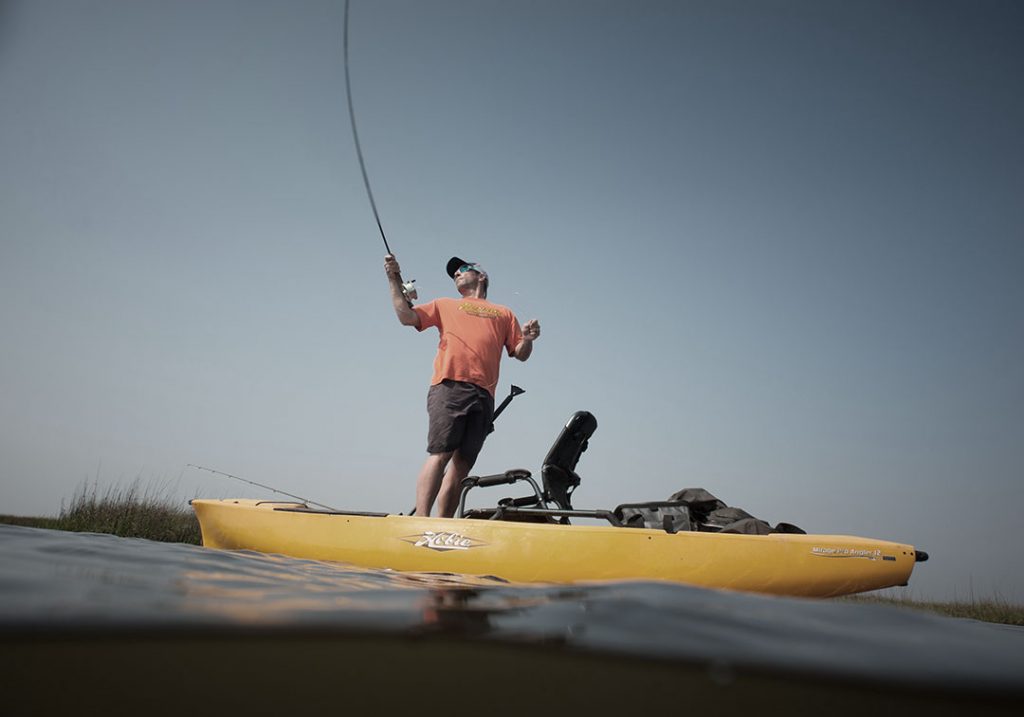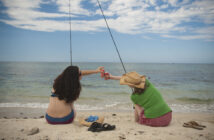
By Kirk Deeter
Editor, Angling Trade
You didn’t have to be Nostradamus to predict that outdoor-related businesses, including those in fly-fishing, would take a financial hit when the Covid-19 pandemic struck. Heck, every business in America took a kick in the shins (including media, trust me). But it was also clear, even early on, that when people were “freed up,” the first place they would go would be the great outdoors.
What I didn’t expect was the sheer magnitude of people throughout the country flocking specifically to rivers and lakes. This makes total sense… fly fishing, or small-craft boating in some form, is by definition social distancing perfected. Moreover, people who would have otherwise been flocking to public swimming pools, youth sports events, concerts, and so on, still don’t have those options. But they can get on lakes and rivers. And from my vantage point in northern Colorado, all you have to do is drive through town or head toward the water and see the masses of folks hauling boats, rafts, pontoons, stand-up paddleboards, and other personal watercraft to know this is all real.
Retail is bouncing back. As reported yesterday, the nation’s retailers saw a nearly 18 percent jump in revenue last month, nearly twice what economists expected. Granted, that’s climbing out of a hole where many retailers had nowhere to go but up. But some fly shops are cashing in, even “ripping” according to at least one shop owner. On Fox News this past Sunday David Leinweber, owner of Angler’s Covey in Colorado Springs talked about this “uptick in demand.” He said he spent April wondering if he’d even have a business in the summer, but when he opened in May he sold 1,000 flies in a single day.
The migration toward water isn’t only happening in Colorado. Here’s a report we received from New Jersey/Pennsylvania/New York: “Upper Delaware was packed with anglers on Friday and Saturday; guides said it was busier than usual weekdays recently. Tons of boats on the back bays of the Jersey Shore a couple of Saturdays ago.” From Idaho/Wyoming: “Interesting that you ask. I hit the Firehole a week ago Sunday. Angling pressure seemed to be about normal, and fishing was good. Then, this past week, I took the camper up to my favorite ‘local’ cutthroat stream, and it was a madhouse. The good news? Not a noticeable uptick in anglers, but a serious crowd of campers/ORV riders. I had to wait in line yesterday at the RV dump in Alpine … Which is not normal. Lots of people out and about.” From Michigan: “It’s not been super crazy on the water up here. It’s nuts downtown (Traverse City), but we’ve been able to find plenty of room at the local lakes and streams to fish. The beach on Lake Michigan has been pretty crazy, but not more than any other summer… We’ve been sticking to little streams, though — I’m sure it’s a different story at the more popular floating destinations.” From Virginia: “I haven’t been out on local lakes, but a buddy was sight-fishing for carp a couple weekends ago (we’re having a cicada hatch) and he said rec boat traffic really muddied up the banks. And that was on a lake with little development.”
Some parts of our industry are still depressed, however. The exotic travel aspect of fly-fishing has been hammered, and likely will be for many months. The American Fly Fishing Trade Association has cancelled its trade show for 2020, responsibly forgoing its predominant source of income. Any manufacturer who does want to proceed with a new product launch must now find a new platform to do so.
Outfitting and guiding is in many places wobbling off the mat, but many have dusted off the gloves and are good to go another few rounds. Some are even starting to counterpunch with effect against the coronavirus.
This much is clear—fly fishing is experiencing a “moment” now, the likes of which we have not seen since the film A River Runs Through It hit screens in 1992. This could even be a “boom” for some, maybe even bigger than that movie phenomenon.
But it’s a different playing field now, and I think that playing field will be the new norm for some time. As I have been diving deeper into all this over the past several weeks, I have flagged some key topics worth discussion. These things might open doors for you now:
1. Sell boats, tubes, kayaks, personal watercraft, whatever… or partner with others who do. I should have tuned into this a month ago when my brother, whom I have seen fly fish maybe one or two times in his entire life, called me to ask advice about buying a kayak. People who wouldn’t otherwise buy boats are buying kayaks, personal rafts—or stand-up paddleboards—in droves. If 2020 does not see record sales for small, human-powered watercraft, I would be absolutely shocked. I talked to one major fly shop owner who didn’t want to be attributed, but shared with me that total sales of his “flagship” fly-fishing brand was X, total sales of a kayak company he started carrying some years ago were X, plus another 50 percent. Granted, not all those boats are sold to fly anglers, and this retailer was on this trend already. It is telling, nonetheless, when a fly shop is making more revenue off personal watercraft than one of its lead fly-product brands.
2. Tap the masses who just found fly water for the first time. Floating down the river the other day on my NRS Gig Bob, I saw a young man casting from the bank. He couldn’t have been more than 20 years old. But he was so happy as he exclaimed, “I’m casting a fly rod for the first time! I just bought this a half-hour ago! I’m so fired up!” And I just said back, “You’re looking great! Stick with it, you’re gonna love it!” There are more first time anglers—whether they are families buying Snoopy rods for the weekend outing, or the person who decides to try fly fishing. People are sipping from the fishing cup. We know that because license sales are up nationwide. It will be the onus of the industry to keep people sipping.
3. Teach people to actually fish for themselves. Not trying to be a downer, but I’m still not sure how many clients from the eastern and western urban corridors will be coming to Rocky Mountain shops or outfitting business to sit in a boat and stare at a bobber in the next couple months. Some for sure, but same as years past? The guide-trip clients I’m hearing about these days are primarily locals, or “regionals.” The best guides in the world are legitimate teachers, and it’s always been that way. If you can actually teach people to fish, especially now, your value and opportunities as a guide go up exponentially.
4. Fish stillwater. With the circus that is evolving and will continue to evolve over the next several months on many rivers, it’s imperative that we look harder at lakes, ponds (certainly the oceans!) and so forth, especially for guide trips. Stillwater fishing is actually challenging and rewarding—and lakes are great places for teaching. Nobody likes crowded rivers, and combat fishing is just bad for fly fishing, especially now.
5. Keep your online business jamming. Every single fly shop I have spoken with (and there have been many) that have had a solid online presence, has reported a year-over-last sales uptick throughout the coronavirus pandemic. Even people who like hanging out in fly shops are more reluctant to do so these days. Heck, even fly shop staffers I know don’t like being there as much as they did a few months ago. If customers can buy stuff online—especially products that don’t need to be tested or fitted (you don’t have to wiggle or check the action of tippet or grasshopper flies)—and support you at the same time, they want to do that.
6. Know how to get people on private water. Trust me, I am totally, completely, emphatically behind the public access movement. But we’re living in a new reality, and that reality involves the notion that some people are yearning to get out and fish in places by themselves or with their families with the understanding that they’re not going to be tripping over other people. If you know how to put a customer on a piece of water where they can catch a few fish or more, and be “cocooned” in that experience, people are going to pay the money to make that happen.
7. Cater to Millennials and Gen Z. From all I’ve heard, $900 rods aren’t flying off the racks. It’s an Echo, Redington, St. Croix environment. And more to the point, a good chunk of the demographic of 70-year-old anglers who have the money to buy high end rods are still staying away from the shop a) because they’re set with gear, and b) they’re afraid of catching coronavirus because they know their age puts them at higher risk. The industry as a whole has been yearning for a means to get younger. Well, this may be the pathway (albeit an unfortunate one) to refocus and affect that change.
8. Buddy up with vacation rental companies. Travel has changed, but it has not ceased. People are driving, not flying. They still desperately want to get away. But they don’t want to stay in a hotel, or a group lodge, and enjoy “family-style” dinners around the table with strangers. They want to go somewhere with their families, and/or a core group of friends they trust. They’ll cook their own food, and find their own space. A friend of mine who manages a region for Vacasa www.vacasa.com for example, told me that house/condo rentals are up dramatically over last year. Tie into those companies like Vacasa, Vrbo, etc., and work partnerships that let their clients know you are the source for fishing, should anyone who stays in these properties want to wet a line.
9. Help anglers plan “bucket list” trips. For every minute anglers have been penned up, and living day-to-day, they’ve also been dreaming. “Where the heck am I going to go when all of this is over?” I’ve been thinking that myself, every day. And I can tell you it will be somewhere far, far away. I hope that’s some consolation for my friends in the fly travel niche. I just think that when the world does fully open up, traveling anglers are going to go large. The pandemic has also forced many to stare right at the “bucket.” And that’s made many bucket lists longer and more elaborate.
10. Promote a conservation ethos. With all these other folks now on rivers, lakes and such, one wonders if conservation groups like Trout Unlimited can make a play for real growth. “This cold, clean water you are enjoying now is brought to you, in part, by Trout Unlimited.” Help TU do this. It will make your fishing better. To those who think conservation groups like TU can reach beyond the hard-core angler, great. Here’s your chance. Go get ‘em, tiger.
11. Don’t get anyone sick via fishing. The only thing that can put everything back on ice is to see people get sick, and have that specifically traced back to their participation in the sport of fly fishing. So please, err on the side of caution. To the guides I saw on the ramp the other day without masks, shaking hands with clients, sharing food and drinks and all that: you might feel like you’re bulletproof. And you might well be. But this industry is not. Please think about others.
Good luck. And as always we’re interested in hearing what’s going on in your business. If we can help, we will.




3 Comments
Good article with many valid points to help rebuild the fly fishing and outdoor industries. Though I’m out of the shop loop first hand, I’ve heard of upticks in online business in my area. Hopefully these new participants in fly fishing will realize and appreciate the value of a good local fly shop that gives good advice, information, and instruction; and that they have to support it to ensure that it stays in business for the long haul. The guide business is picking up for me with most of my new clients being beginning fly fishers who’ve never fly fished before-an encouraging sign of growth in our sport. If those of us in the industry stay safe, strong, smart, and be patient with and welcoming to new anglers(no question is a dumb question) we’ll come out of COVID-19 in a better place.
Great article I have stumbled upon now in the aftermath of the pandemic. The time at home allowed me to hone my skills to transition from being a spin caster over to learning fly fishing. Fast forward to 2022, being a 30 year old female in the fly fishing industry now, all of these points really hit the mark. The pandemic has given way to a resurgence in younger anglers and more diversified anglers. The fly fishing school I attended this Spring (TUFFS.Org) had more women my age than I could have ever imagined and it really made me feel included and seen in the sport. On point #7, however, the high end rods have been the choice to go ‘all in’ with now outfitting over $6,000 in gear of Winston rods and Ross reels alone this year, in an effort to ‘stick with and invest in’ my biggest hobby of all time. Integrations of social media, more diversity in the sport, and the overlap of women who may like to sew with the hobby of fly tying would be my idea of the inclusive approach moving forward. Personally being a homesteader as well, the use of fur and feathers already on the farm (and many more young women homesteading now) gives way to neat integrations for fly tying in the sport as well.
Great advice! Thanks !